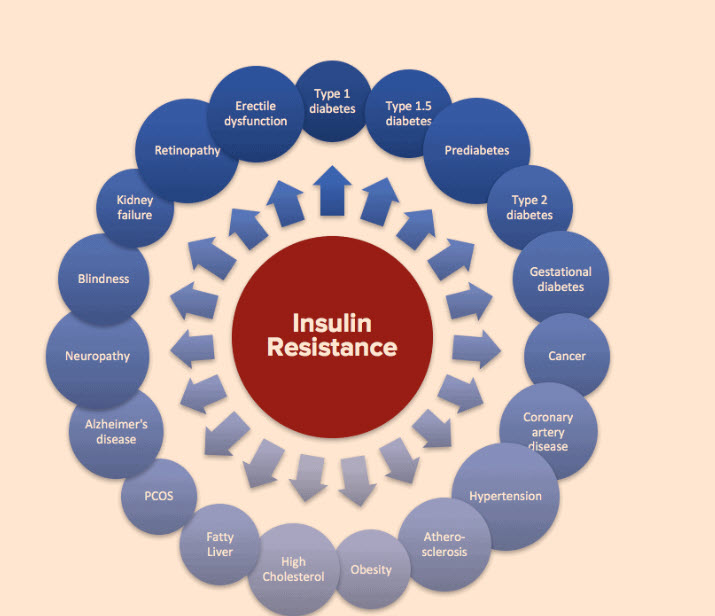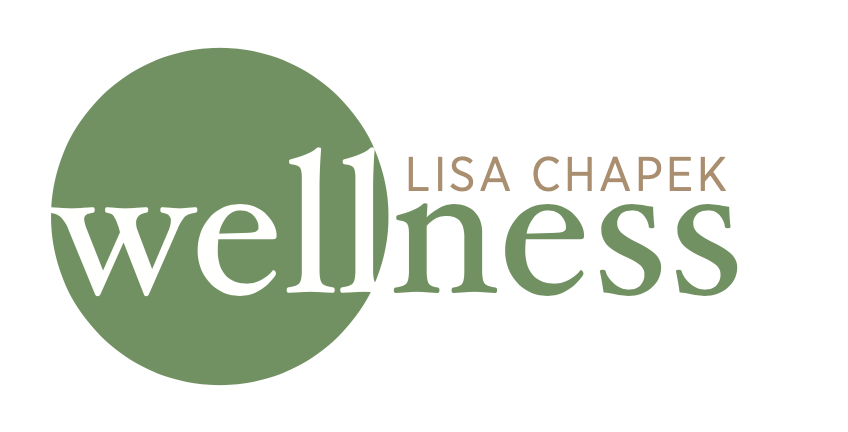Stay informed with
the latest insights
and resources

Insulin Resistance Causes, Treatment and the Best Measurement Tools and Calculations
Insulin Resistance Causes, Treatment and the Best Measurement Tools and Calculations
Ronald Grisanti D.C., D.A.B.C.O., DACBN, MS, CFMP
What Is Insulin Resistance?
Insulin resistance also known as impaired insulin sensitivity, happens when cells in your muscles, fat and liver don't respond as they should to insulin, a hormone your pancreas makes that's essential for life and regulating blood glucose (sugar) levels.
The following is a good understanding of the mechanism occurring in a person with insulin resistance and patient with Insulin sensitivity:
Let's say we feed a healthy person a high glycemic carbohydrate-containing meal. In the healthy person with optimal insulin sensitivity, the insulin is adequately released by the pancreas in response to the rise in blood glucose. Insulin causes most of that glucose (about 80-90%) to be absorbed by the liver and muscle and converted into glycogen.
However, in the resistant person, insulin fails to induce the same level of glucose uptake by the muscle and liver, despite the fact that their pancreas is releasing more insulin in an attempt to overcome their resistance. Basically, insulin fails to block the production of glucose leading to higher blood sugar compared to the healthy person.

Patient with Insulin Resistance

Patient with Insulin Sensitivity
Insulin Resistance Symptoms

What Causes Insulin Resistance?
Insulin resistance can be genetic. However, there are also acquired causes of insulin resistance. Let's learn more about them:
1: Excess body fat
Research shows that obesity, particularly excess fat around your waist and organs, is also known as visceral fat.
Visceral fat increases inflammation in your body, which can contribute to insulin resistance.
2: Physical inactivity
Physical activity increases your insulin sensitivity and helps you build lean muscle mass, which helps absorb glucose from your blood and keep your blood sugar levels in check.
However, a lack of physical activity can have the opposite effect. Leading a sedentary lifestyle with no to little physical activity can lead to obesity, which can increase insulin resistance.
3: Diet
Highly processed diets that have a high amount of simple high glycemic carbohydrates and saturated fats get digested very quickly by your body and spike your blood sugar levels. If this eating pattern continues on a extended period of time the increased blood sugar levels have the potential to increase insulin resistance.
The glycemic index (GI) is a standardized scale that ranks foods from 0 to 100 based on how quickly they are digested and absorbed by the body and how they impact blood sugar levels. Foods with a high GI (70 or more) are digested and absorbed quickly, causing blood sugar to spike. Foods with a low GI (55 or less) are digested more slowly, causing a more gradual rise in blood sugar
4: Poor Gut Health- Increased Intestinal Permeability (aka: Leaky Gut)-It is postulated that endotoxin-induced inflammation which results from gut-permeability also contributes to the development of insulin resistance
5: Genetics- Many single nucleotide polymorphisms (SNPs) have been associated with insulin resistance in the general population, including:

I recommend the following genetic lab:
DNA Type 2 Diabetes Risk Test by Genex Diagnostics
https://www.genexdiagnostics.com/dna-type-2-diabetes-test/
6: Medicines
Certain medications, such as steroids and certain hypertension and psychiatric disorders, can lead to insulin resistance.
7: Medical conditions
Certain medical conditions – hormonal and genetic can increase insulin resistance.

Insulin Resistance: The Damage It Causes
Insulin resistance triggers a cascade of reactions in your fat cells and liver which cause elevated levels of fatty acids and cholesterol to be released into your bloodstream.
If insulin resistance is not managed on time, it can lead to severe complications such as high cholesterol, hypertension, vascular complications, and hardened arteries. It can also lead to an increased risk of stroke, cardiovascular disease, and type 2 diabetes.
Diseases Associated with Insulin Resistance

Credit to https://www.masteringdiabetes.org/
Blood Work for Diagnosis of Insulin Resistance
Bloodwork can be a useful tool in the assessment and diagnosis of insulin resistance. Some blood work markers that are associated with insulin resistance include:
Fasting Glucose
Fasting Triglycerides
Fasting Insulin
Triglyceride/HDL ratio
Hemoglobin A1C (HbA1c)
LP-IR Score ( See Grid Above)
C-Peptide
Oral Glucose Tolerance Test (OGTT)
High LDL Cholesterol
How to Measure and Calculate for Insulin Resistance
You show no insulin resistance if your meet the following metrics:
Fasting glucose is between 75–95 mg/dL (4.2–5.3 mmol/L).
TG:HDL ratio is near 1.0, +/- 0.5.
Fasting insulin is between 3–8 uIU/mL (18–48 pmol/L).
HgbA1C level is less than 5.6% (<37 mmol/mol).
Glucose/insulin as HOMA-IR is near 1 (.5–1.5).
Your total body fat is <28% for men and <32% for women.
You show slight insulin resistance if you have two or more of the following metrics:
Fasting glucose is greater than 95 mg/dL (5.3 mmol/L).
TG:HDL ratio is greater than 2.
Fasting insulin is greater than 8 uIU/mL (>48 pmol/L).
HgbA1C level is greater than 5.5% (>36 mmol/mol).
HOMA-IR is greater than 1.5.
The skin fold at your hip is greater than that at your triceps (by at least 5 mm).
You show moderate insulin resistance if you have three or more of the following metrics:
Fasting glucose is greater than 100 mg/dL (>5.6 mmol/L).
TG:HDL ratio is 3 or greater.
Fasting insulin is greater than 10 uIU/mL (>60 pmol/L).
HgbA1C level is greater than 5.7% (>39 mmol/mol).
HOMA-IR is greater than 2.5.
The skin fold at your hip measures near twice that at your triceps.
You show severe insulin resistance if you have three or more of the following:
Fasting glucose is greater than 110 mg/dL (>6.1 mmol/L). Greater than 125 mg/dL (>7.0 mmol/L) is diabetes.
TG:HDL ratio is greater than 4.
Fasting insulin is greater than 12 uIU/mL (>72 pmol/L).
HgbA1C level is greater than 6.0% (>42 mmol/mol). Greater than 6.4% (>46 mmol/mol) is diagnostic of diabetes.*
HOMA-IR is greater than 3.
The skin fold at your hip measures over twice that at your triceps.
The following are two clinically established tools to determine if you have Insulin Resistance
HOMA-IR stands for Homeostatic Model Assessment of Insulin Resistance
HOMA-IR Calculator — Insulin Resistance
https://www.mdcalc.com/calc/3120/homa-ir-homeostatic-model-assessment-insulin-resistance
Healthy Range: 1.0 (0.5–1.4)
Less than 1.0 means you are insulin-sensitive which is optimal.
Above 1.9 indicates early insulin resistance.
Above 2.9 indicates significant insulin resistance.
The triglyceride-glucose (TyG) index
https://www.mdapp.co/tyg-index-calculator-359/
<4.49 indicates being insulin sensitive
>4.49 indicates being insulin resistance
Effective Treatment to Reverse Insulin Resistance
1: Get Adequate and High-Quality Sleep
Getting adequate high-quality sleep is important for a number of functions in the body, but recent research has shown it is especially important for healthy metabolic function. It is recommended to aim for 7-9 hours of high-quality sleep, and getting less than 5 hours of sleep per night has been shown to decrease insulin sensitivity, increase sugar cravings, and is considered a risk factor for developing insulin resistance. Research suggests that getting enough quality sleep can help reverse insulin resistance. A 2022 review in Cureus found that poor quality sleep can disrupt hormone balance and increase the risk of insulin resistance. In one study, volunteers who restricted their sleep for four nights saw their insulin sensitivity drop by 23%, but two nights of extra sleep helped restore normal levels.
2: Engage in a Regular Exercise Routine
Exercise is one of the best ways to improve your insulin sensitivity. Exercise helps to move sugar into the muscles for storage, with benefits lasting 2-48 hours after exercise. Both cardiovascular and resistance training have been found to be beneficial, so the best kind of exercise is the type that you enjoy, and will participate in on a regular basis.
It is generally recommended that adults engage in 150-300 minutes of low-intensity or 75-150 minutes of vigorous exercise per week.
Aerobic (cardio) and resistance training (strength) are equally important. Some studies suggest that doing both types of exercise provide greater benefits than doing either one alone.
When you are physically active, your muscles are more responsive to insulin, resulting in improved uptake of glucose by your muscles which promotes healthier blood sugar levels.
Muscle is the fountain of youth and one of the essential keys to reversing insulin resistance.
Strength training should be the cornerstone of your exercise program.
Strive to Stay in Zone 2 Cardio 5 days a week.
Read my article on Zone 2 Training
https://www.functionalmedicineuniversity.com/public/1967.cfm
With proper clearance from your physician I suggest incorporating High Intensity Interval Training (HIIT) twice per week
https://www.functionalmedicineuniversity.com/public/1770.cfm

Diet alone amounted to a 48% increase in improving Insulin Sensitivity and Diet and Exercise together increased insulin Insulin Sensitivity to 110%
3: Reduce Your Stress Levels
Research has demonstrated a link between chronic stress and insulin resistance and metabolic dysfunction. Reducing stress can help reverse insulin resistance. Stress can be a risk factor for insulin resistance because stress hormones like cortisol and adrenaline can make it harder for insulin to work properly. This can lead to increased blood sugar levels, also known as hyperglycemia. Stress is a risk factor for insulin resistance, as high levels of stress hormones can disrupt glucose metabolism.
4: Focus on a Healthy Diet
Nutrition is a key component of maintaining a healthy weight and preventing or reversing insulin resistance. A diet based on whole foods, including fruits, vegetables, nuts, seeds, and high-quality protein has been shown to be most beneficial for blood sugar regulation.
A balanced meal contains lean protein (like fish), healthy sources of carbs (vegetables, legumes, fruit & whole grains), and healthy fats/oils (nuts, seeds, olives, olive oil & avocados – not trans fats or partially hydrogenated oils).
Strive to get 30-40 grams of protein per day. Although I advocate a more plant based protein source such as soybean products, seitan, beans, and lentils contain high amounts of protein. You can also find protein in nuts, whole grains like quinoa and amaranth, and hemp seeds.
Lean muscle can improve insulin sensitivity. Studies have shown that people with more muscle mass and less fat have lower insulin resistance than people with less muscle mass and more fat. Additionally, strength training and other types of exercise can increase muscle mass and insulin sensitivity.
Leucine plays a key role in building new muscle tissue. It is needed to signal the process of building new muscle.
In fact, leucine is the most powerful activator of muscle growth out of all other amino acids.
With that said, it is recommended to focus on consuming a minimum of 2.5 grams per meal.

2.5 grams per meal of Leucine is essential to optimize increase lean muscle mass Credit to: https://optimisingnutrition.com/
The following foods groups will supply 2.5 grams of Leucine

Credit to: https://optimisingnutrition.com/

Credit to: https://optimisingnutrition.com/

Credit to: https://optimisingnutrition.com/
It is recommended by leading research that 2.5 grams of leucine per meal can trigger the body's muscle-building process for five to six hours and improve insulin sensitivity
Fruits and vegetables: The overall healthy diet that I recommend to anyone is plant-based, unprocessed foods.
Fill half your plate with vegetables daily
Aim for 6 servings daily of the non-starchy vegetables like asparagus, leafy greens (if you are on blood thinners, check with your physician first), broccoli, onions, radishes, etc.
You can eat an unlimited amount of Non-starchy vegetables without causing glucose/insulin spikes

Soluble fiber: Soluble fiber is found in food such as beans, legumes, oatmeal, whole grains, sweet potatoes and Brussels sprouts
There are two types of fiber: soluble and insoluble. Soluble fiber attracts water and turns into a gel-like substance, which helps to slow digestion. Insoluble fiber (sometimes called “roughage”) adds bulk to stool and allows food to pass more quickly.
Since soluble fiber slows digestion, it helps you feel fuller for longer, which prevents overeating and aids in weight loss. It also helps to reduce visceral fat—a dangerous form of fat that surrounds internal organs like your liver, stomach, and intestines. Visceral fat raises the risk of many health conditions, including diabetes and heart disease. People with a large waistline tend to have visceral fat.
One study found that for every 10-gram increase in soluble fiber, visceral fat accumulation decreased by 3.7%.
Optimal goal for Fiber intake:
35 grams a day of fiber for men
25 grams a day of fiber for men
Fiber is key to promoting a healthy blood sugar and preserving insulin sensitivity. Vegetables, avocados, and, especially, legumes are good sources of fiber. Whole grains are another good source of fiber.
Low glycemic carbohydrates: When choosing carbohydrates, it's important to select carbohydrates with a low glycemic load. Some smart choices include green vegetables, non-starchy vegetables, sweet potatoes, berries and gluten-free whole grains. In addition, it's important to limit high glycemic types of carbohydrates, including refined sugars, refined grains, processed foods, and sugary drinks.
When building a meal, it is important to build a balanced plate. A rule of thumb is to include a complex carbohydrate, a high-quality plant based protein (approximately 10 ounces of fish and lean meat), a healthy fat, and a source of fiber in every meal. Eating all of these components together will help to slow the digestion of the meal, preventing a high blood sugar spike.
Read Labels and Look to keep total added sugars to less than 24 grams for women and 36 grams for men.

Read Labels Look to keep total added sugars to less than 24 grams for women and 36 grams for men
The following is an effective recipe for success when it comes to reversing insulin resistance.
Based on the work of Cyrus Khambatta PhD, Robby Barbaro MPH, authors of the outstanding book: Mastering Diabetes: The Revolutionary Method to Reverse Insulin Resistance Permanently in Type 1, Type 1.5, Type 2, Prediabetes, and Gestational Diabetes, I have witnessed LONG TERM improvements in Diabetes and Insulin Resistance Reversal.
There are 3 categories:
The green light category contains the foods that you can eat ad libitum (i.e. as much as you want). These are all unrefined whole foods. They are optimal for reversing insulin resistance and there is no need to limit how much to eat.
The yellow light category contains foods that you can include in small quantities, because they are either slightly processed or have a higher fat content. They shouldn't be daily staples, but they are still considered “healthy” choices.
The red light category contains the foods that we recommend removing from your fridge, your kitchen cabinets, and most importantly your plate. These foods have been documented by evidence-based research to cause insulin resistance, increase your blood glucose, and promote chronic diseases.

Credit to https://www.masteringdiabetes.org/
My suggestions are a little more liberal when it comes to the introduction of some fish and lean cuts of meat.
The preponderance of evidence recommending a more plant based diet with no more than 6-10 ounces per week of antibiotic-free, organic/grass-fed meat/fish has proven over and over again to improve health longevity and the reversal of disease (cardiovascular, diabetes, auto-immune disease, etc) including the topic of today's article on insulin resistance.
I realize I will get pushback from those who are strong advocates of low carb, high protein and high fat diet.
Although it is undeniable that one will see impressive SHORT TERM health benefits, the long term complications are worrisome.
Please read my article titled: Low Carb/High Protein and Increased Mortality
https://www.functionalmedicineuniversity.com/public/1989.cfm
The Position on the Camp of Increased Consumption of Saturated Fats
Saturated fat can worsen insulin resistance in humans. Studies have shown that a diet high in saturated fat is associated with insulin resistance and the development of type 2 diabetes. Saturated fat can have a direct effect on insulin resistance in skeletal muscle and the liver.
Saturated fat can increase the amount of diacylglycerol in muscles, which can have a strong effect on muscle insulin resistance.
Saturated fat can activate the toll-like receptor 4 (TLR-4) receptor in the liver, which can lead to the production of ceramide and inhibit insulin signaling.
Avoid or at reduce artificial sweeteners such as sucralose, acesulfame potassium, aspartame, saccharin and maltodextrin.
You can use Stevia monk fruit and allulose.
5: Maintain a Healthy, Ideal Weight and Bodyfat Level
Excessive weight, particularly in the belly area, has been associated with an increased risk of insulin resistance and increased risk of type 2 diabetes. A study by Johns Hopkins University found a weight loss of 5-7% correlated with a 54% decrease in the risk of developing type 2 diabetes.

Read my article on Achieving Your Ideal Weight
https://www.functionalmedicineuniversity.com/public/2033.cfm
6: Stay Hydrated-total water intake (≥2,657 mL or >90 ounces) was associated with lower insulin resistance.
7: Intermittent fasting-- a daily 12-14 hour fast is a great habit to implement to lower insulin resistance.
8: Herbs for Insulin resistance
A number of herbs have been shown to increase insulin sensitivity. Herbs that have been found to increase insulin sensitivity include:
Fenugreek seeds: These seeds are high in fiber, helping to slow digestion, and control blood sugar spikes.
Turmeric: Turmeric contains curcumin and has been shown to aid in insulin sensitivity by reducing sugar and free fatty acids in the blood.
Cinnamon: Cinnamon has been shown to help lower blood sugar levels and improve insulin sensitivity.
Ginger: Ginger has been shown to increase insulin secretion, helping to lower blood sugar levels after a meal. It has also been shown to increase insulin sensitivity.
9: Nutraceuticals for Insulin Sensitivity
Chromium: Chromium has been shown to improve insulin sensitivity and lower blood sugar levels. Chromium works by binding to insulin receptors on the surface of cells. This enhances insulin activity, so less of the hormone is needed to move glucose out of the blood.
Magnesium: Magnesium is used by the body's insulin receptors, and a magnesium deficiency has been associated with insulin resistance. Taking magnesium supplements may help to improve insulin sensitivity in those with low magnesium levels.
Resveratrol: Resveratrol is naturally found in the skin of grapes and berries. In its concentrated form, it has been shown to improve insulin sensitivity.
Berberine: major studies of berberine found that it had similar effects on blood sugar as the diabetes drug metformin (Glucophage). Those who took berberine experienced reductions in A1c, fasting glucose, post-meal glucose, and triglyceride levels.
Pendulum Glucose Control- I have seen amazing improvement in glucose management and reversal in insulin resistance
https://pendulumlife.com/products/pendulum-glucose-control-2-og

Apple cider vinegar: Apple cider vinegar has increased in popularity over the past few years due to its ability to increase insulin sensitivity in those with insulin resistance and type 2 diabetes.
Omega 3-Omega-3 fatty acids can potentially improve insulin resistance by improving mitochondrial function and beta-oxidation, regulating the secretion of adipocytokines, and inhibiting the remodeling of adipose tissue
Dr. Grisanti's Comments:
Although I agree approximately 80-85 percent with the work of Cyrus Khambatta PhD, Robby Barbaro MPH, I still have seen outstanding results with reversing Type 2 Diabetes and reversing insulin resistance with the science based Mediterranean Diet.
https://www.functionalmedicineuniversity.com/mediterranean-diet1.pdf
I understand that some reading this article may express some level of confusion in the two presented ways of eating.
I want to be very transparent and simply say that it comes to MODERATION and BLEND. Leaning more toward a Mediterranean Diet/Dominant Plant Based Diet will consistently produce outstanding clinical outcomes.
The issue that one needs to consider is carbohydrate tolerance level.
Everyone has a different carbohydrate tolerance level, which is the amount of carbohydrates they can eat before their blood glucose levels rise. For example, some people can tolerate 25 grams of carbohydrates per day, while others can tolerate 100 grams. To calculate your carbohydrate tolerance level, you can track how many grams of carbohydrates you eat each day and measure your fasting blood glucose level in the morning. You can also consider testing your response after eating certain foods, such as brown rice, oats, quinoa, sweet potatoes, beets, corn, lentils, and bananas
Exercise is extremely beneficial to your overall health and a vital part of reversing insulin resistance, but the truth is that you can't exercise your way out of a bad diet.
To reverse insulin resistance and reduce your risk of chronic disease, you need to follow a whole food diet that provides you with 30-40 grams of quality protein per three meals a day, plenty of low glycemic vegetables, legumes and healthy fats.
Books I Recommend:
The End of Diabetes: The Eat to Live Plan to Prevent and Reverse Diabetes by Joel Fuhrman M.D.
Mastering Diabetes: The Revolutionary Method to Reverse Insulin Resistance Permanently in Type 1, Type 1.5, Type 2, Prediabetes, and Gestational Diabetes by Cyrus Khambatta PhD, Robby Barbaro MPH
Dr. Neal Barnard's Program for Reversing Diabetes: The Scientifically Proven System for Reversing Diabetes Without Drugs by Neal Barnard
Metabolical: The Lure and the Lies of Processed Food, Nutrition and Modern Medicine: Unpacking the Science Behind Food and Health by Robert H Lustig
Forever Strong: A New, Science-Based Strategy for Aging Well by Dr. Gabrielle Lyon
If you are not physically active, it is best to check with your healthcare provider before starting an exercise regimen.
References:
** Always consult with a physician or healthcare practitioner with significant integrative or functional medicine training before starting any of the above recommendations.
The information on this website is not intended to replace a one-on-one relationship with a qualified health care professional and is not intended as medical advice. It is intended as a sharing of knowledge and information from the research and experience of Dr. Grisanti and his functional medicine community. Dr. Grisanti encourages you to make your own health care decisions based upon your research and in partnership with a qualified health care professional. Visit www.FunctionalMedicineUniversity.com for more information on our training in functional medicine. Look for practitioners who have successfully completed the Functional Medicine University's Certification Program (CFMP) www.functionalmedicinedoctors.com. This content may be copied in full, with copyright, contact, creation and information intact, without specific permission, when used only in a not-for-profit format. If any other use is desired, permission in writing from Dr. Grisanti is required


